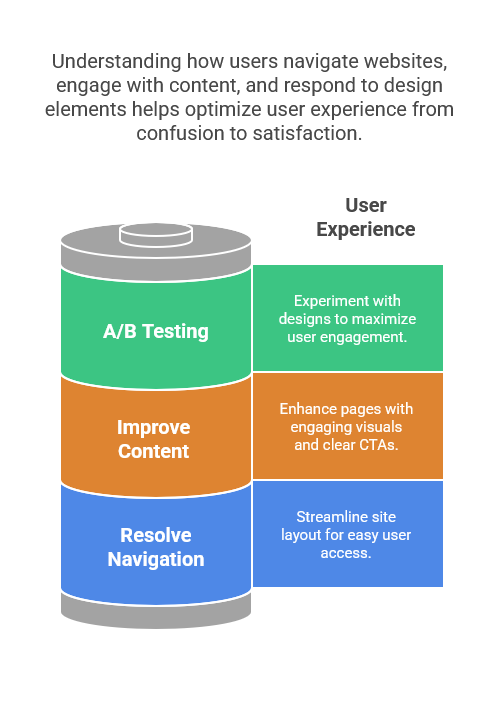Website analytics is the process of collecting, measuring, and analysing data from a website to understand how users interact with it. Through website analytics, businesses can track various metrics, such as page views, bounce rates, user behaviour, conversions, and more. These metrics help inform decisions to improve a website’s overall performance.
In simple terms, website analytics gives you a snapshot of your website’s health and performance. It tells you how well your site is attracting visitors, how users are engaging with your content, and which areas need improvement.
Why Website Analytics Are Important?
Website analytics are crucial for businesses, marketers, and website owners for several reasons. They provide insights into website performance, user behaviour, and the effectiveness of marketing strategies. Understanding these insights is essential for making data-driven decisions.
Here are some specific reasons why you should care about website analytics:
-
Track Performance: Website analytics help you understand if your website is meeting the goals you’ve set. For example, if your goal is to increase sales, website analytics will show you whether visitors are converting into customers.
-
Improve User Experience: Website analytics tools can track user behaviour, such as where they click, how long they stay on a page, and what actions they take. By analysing this data, you can make improvements to the site’s user interface and ensure a smoother experience for visitors.
-
Measure Marketing Success: Website analytics help measure the success of your marketing campaigns. You can track how much traffic each marketing channel brings and which sources deliver the best results.
-
Identify Areas for Improvement: Website analytics can highlight parts of your website that are underperforming. You can identify high bounce rates or low conversion rates, which will guide your efforts in improving those areas.
In short, website analytics empower businesses to measure success, identify opportunities for growth, and improve the overall user experience.

Key Website Analytics Metrics to Monitor
When analysing your website, it’s crucial to keep an eye on specific metrics that directly impact your site’s performance. These metrics will provide valuable insights that will help you understand how your website is performing and how to optimise it for better results.
Here are some of the most important metrics to monitor:
a) Page Views
Page views indicate the total number of times a specific page on your website has been viewed. This is a basic metric, but it can give you a general idea of which pages are attracting the most visitors. For example, if your product page gets more views than other pages, you may want to optimise that page for better conversion rates.
b) Bounce Rate
Bounce rate refers to the percentage of visitors who land on a page and leave without interacting further. A high bounce rate can indicate that the page is not engaging enough or does not provide the information visitors were looking for. It may also indicate issues with page loading times, irrelevant content, or a poor user experience.
c) Session Duration
Session duration refers to the average time users spend on your site during a single visit. Longer session durations typically indicate that visitors are finding your content engaging. If users spend only a short time on your site, it may suggest that they are not interested in the content or are unable to find what they are looking for.
d) Conversion Rate
Conversion rate is the percentage of visitors who take a desired action on your website, such as making a purchase, signing up for a newsletter, or filling out a contact form. The conversion rate is a critical metric because it indicates how effectively your website converts visitors into customers or leads. Tracking this metric allows you to optimise your website and marketing efforts for higher conversions.
e) Traffic Sources
This metric shows you where your website visitors are coming from. It can be organic search, paid ads, social media, email campaigns, or referrals from other websites. Understanding your traffic sources helps you focus your marketing efforts on the most effective channels.
Website Analytics Tools You Can Use
To collect and analyse your website’s data, you need to use website analytics tools. These tools make it easier to track your metrics, interpret the data, and implement improvements.
Some of the most popular website analytics tools include:
a) Google Analytics
Google Analytics is the most widely used and powerful website analytics tool. It provides detailed insights into website traffic, user behaviour, conversions, and much more. It’s free to use and offers a wide range of features, making it ideal for businesses of all sizes. With Google Analytics, you can monitor real-time data, track e-commerce transactions, and set up custom goals to measure specific actions.
b) Hotjar
Hotjar is a user behaviour analytics tool that helps you understand how visitors interact with your website. It offers features like heatmaps, session recordings, and surveys to track user activity. By using Hotjar, you can visualise how users click, scroll, and navigate your site, which can help you optimise your website’s layout and content for better engagement.
c) SEMrush
SEMrush is an SEO-focused analytics tool that tracks keyword rankings, backlinks, and website traffic. It’s particularly useful for monitoring the success of your SEO efforts and identifying areas where your site can improve its visibility in search engines. SEMrush also provides a competitive analysis, enabling you to compare your website with those of your industry peers. Official Website
d) Crazy Egg
Crazy Egg provides heatmaps and user session recordings to help you understand how visitors interact with your site. It also offers A/B testing, which allows you to test different variations of a page to determine which one performs better. Crazy Egg helps optimise your site’s design and usability by showing where users are engaging most.
e) Adobe Analytics
Adobe Analytics is a comprehensive analytics tool that provides in-depth reporting and insights. It allows you to track website performance, analyse customer behaviour, and measure ROI. It is particularly useful for larger enterprises or businesses that require advanced analytics.

Interpreting Website Analytics Data
After collecting data from your analytics tools, it is essential to interpret it accurately. Simply having data is not enough; understanding what the data means and how it impacts your website is key to making informed decisions.
Here are some tips for interpreting your website analytics data:
-
Identify Patterns: Look for patterns in your data. Are there any spikes or drops in traffic? What happened around those times? Did you launch a new marketing campaign or make a website update that could explain the changes?
-
Compare Metrics: Compare different metrics to understand their relationships. For example, if your traffic is high but your conversion rate is low, it might suggest that your site’s content isn’t persuasive enough, or your landing pages need improvement.
-
Use Segmentation: Segment your data by traffic source, user location, or device type to get a clearer picture of how different groups interact with your site. This can help you tailor your website’s content and marketing strategies for specific audiences.
-
Track Trends Over Time: Website analytics is most useful when you track data over time. Don’t just focus on daily or weekly fluctuations. Look at long-term trends to see how your website is evolving.
Using Website Analytics to Improve User Experience
Website analytics are not only useful for tracking performance but also for improving user experience. By understanding how visitors interact with your site, you can identify issues and make adjustments to enhance usability.
Here are a few ways to improve user experience with website analytics:
-
Resolve Navigation Issues: If visitors struggle to find the information they need, it may be due to poor website navigation. Analytics tools can show you which pages are visited most often, which can help you streamline your site’s layout and make it easier for users to find what they need.
-
Improve Content: If certain pages have high bounce rates, consider improving the content on those pages. This could mean adding more engaging visuals, breaking up text into smaller paragraphs, or making calls-to-action clearer.
-
A/B Testing: Conduct A/B tests to experiment with different page designs, headlines, or CTAS. By tracking user engagement and conversion rates, you can identify which variations are most effective for your audience.

Website Analytics and SEO
SEO (Search Engine Optimisation) is crucial for improving your website’s visibility in search engines, and website analytics play a big role in tracking your SEO efforts.
Here’s how website analytics can help with SEO:
-
Track Organic Traffic: Monitor how much organic traffic your site gets from search engines. If traffic is low, you may need to revisit your SEO strategy.
-
Measure Keyword Performance: Track the performance of the keywords you’re targeting. Are you ranking higher? Are your rankings improving over time? Analytics tools can help you see the results of your SEO work.
-
Monitor Backlinks: Backlinks play a significant role in SEO. Use analytics tools to monitor your backlinks and see how they contribute to your site’s ranking.
FAQS About Website Analytics
1. What is the best tool for website analytics?
Google Analytics is the most popular and widely used tool for website analytics. It provides detailed insights into website performance and is available for free.
2. How often should I check my website analytics?
You should regularly check your website analytics. It is recommended to monitor for any significant changes or trends at least once a week.
3. How do I improve my website’s bounce rate?
Improving your content, speeding up your website, and making it easier to navigate can help lower your bounce rate.
4. Can website analytics help with SEO?
Yes, website analytics can track keyword performance, organic traffic, and backlinks, all of which are important for SEO.
5. How do I track conversions on my website?
You can set up conversion goals in Google Analytics to track specific actions, such as purchases or form submissions.
Website analytics are a powerful tool for understanding your site’s performance and improving its effectiveness. By tracking key metrics, utilising the right analytics tools, and interpreting the data effectively, you can optimise your website for a better user experience, increased conversions, and a higher ROI. Make data-driven decisions to stay ahead of the competition and drive business growth.

